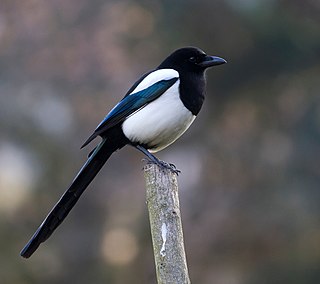
Magpies are birds of the Corvidae family. Like other members of their family, they are widely considered to be intelligent creatures. The Eurasian magpie, for instance, is thought to rank among the world's most intelligent creatures and is one of the few nonmammalian species able to recognize itself in a mirror test. They are particularly well known for their songs and were once popular as cagebirds. In addition to other members of the genus Pica, corvids considered as magpies are in the genera Cissa, Urocissa, and Cyanopica.
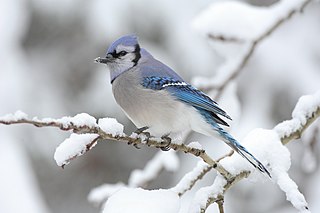
Corvidae is a cosmopolitan family of oscine passerine birds that contains the crows, ravens, rooks, magpies, jackdaws, jays, treepies, choughs, and nutcrackers. In colloquial English, they are known as the crow family or corvids. Currently, 135 species are included in this family. The genus Corvus containing 47 species makes up over a third of the entire family. Corvids (ravens) are the largest passerines.

The yellow-billed magpie(Pica nuttalli), also known as the California magpie, is a large corvid that inhabits California's Central Valley and the adjacent chaparral foothills and mountains. Apart from its having a yellow bill and a yellow streak around the eye, it is virtually identical to the black-billed magpie (Pica hudsonia) found in much of the rest of North America. The scientific name commemorates the English naturalist Thomas Nuttall.
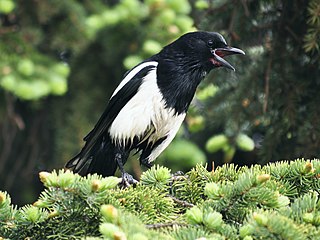
The black-billed magpie, also known as the American magpie, is a bird in the corvid family found in the western half of North America. It is black and white, with black areas on the wings and tail showing iridescent hints of blue or blue-green. It is one of only four North American songbirds whose tail makes up half or more of the total body length.

The Eurasian magpie or common magpie is a resident breeding bird throughout the northern part of the Eurasian continent. It is one of several birds in the crow family (corvids) designated magpies, and belongs to the Holarctic radiation of "monochrome" magpies. In Europe, "magpie" is used by English speakers as a synonym for the Eurasian magpie: the only other magpie in Europe is the Iberian magpie, which is limited to the Iberian Peninsula. Despite having a shared name and close appearance, it is not closely related to the Australian Magpie.

Cyanopica is a genus of magpie in the family Corvidae. They belong to a common lineage with the genus Perisoreus. The generic name is derived from the Latin words cyanos, meaning "lapis lazuli", and pica, meaning "magpie".

The azure-winged magpie is a bird in the crow family. It is 31–35 cm long and similar in overall shape to the Eurasian magpie but is more slender with proportionately smaller legs and bill. It belongs to the genus Cyanopica.

The passerine birds of the genus Aphelocoma include the scrub jays and their relatives. They are New World jays found in Mexico, western Central America and the western United States, with an outlying population in Florida. This genus belongs to the group of New World jays–possibly a distinct subfamily–which is not closely related to other jays, magpies or treepies. They live in open pine-oak forests, chaparral, and mixed evergreen forests.

Pica is a genus of seven species of birds in the family Corvidae in both the New World and the Old.

The piapiac is an African bird in the crow family, and is the only member of the genus Ptilostomus. It is most closely related to the Central Asian ground jays.

The Oriental magpie-robin is a small passerine bird that was formerly classed as a member of the thrush family Turdidae, but now considered an Old World flycatcher. They are distinctive black and white birds with a long tail that is held upright as they forage on the ground or perch conspicuously. Occurring across most of the Indian subcontinent and parts of Southeast Asia, they are common birds in urban gardens as well as forests. They are particularly well known for their songs and were once popular as cagebirds.

The white-throated magpie-jay is a large Central American species of magpie-jay. It ranges in Pacific-slope thorn forest from Jalisco, Mexico to Guanacaste, Costa Rica. Magpie-jays are noisy, gregarious birds, often traveling in easy-to-find flocks, mobbing their observers.

The Oriental magpie is a species of magpie found from south-eastern Russia to eastern China, Korea, Taiwan, Japan and northern Indochina and Myanmar. Other names for the Oriental magpie include Chinese magpie and Asian magpie. The magpie is the national bird of Korea.

The Magpie is a British breed of domestic duck. It has distinctive black and white markings reminiscent of the European magpie, and is a good layer of large eggs.
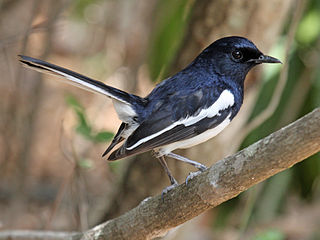
The Madagascar magpie-robin is a species of chat in the Old World flycatcher family, Muscicapidae.

Plectorhinchus pica, the painted sweetlips, dotted sweetlips, magpie sweetlips or spotted sweetlips, is a species of marine ray-finned fish, a sweetlips belonging to the subfamily Plectorhinchinae, one of two subfamilies in the family Haemulidae, the grunts. It is native to coral reefs of the Indian Ocean and the western Pacific Ocean. It is a commercially important species and can be found in the aquarium trade.
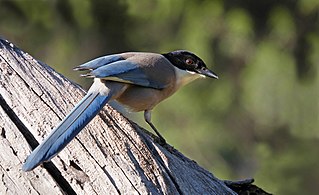
The Iberian magpie is a bird in the crow family. It is 31–35 cm (12–14 in) long and similar in overall shape to the Eurasian magpie but is slenderer with proportionately smaller legs and bill. It belongs to the genus Cyanopica.
The Asir magpie, also known as the Arabian magpie, is a highly endangered species of magpie endemic to Saudi Arabia. It is only found in the country's southwestern highlands, in the Asir Region. It occurs only in African juniper forest in well-vegetated wadis and valleys. It was formerly classified as a subspecies of the Eurasian magpie, and still is by many authorities. This species is highly threatened by habitat destruction, as its native forests are not regenerating. Tourism development and climate change are also posing a threat. Only 135 pairs are known to survive in the wild, and this number is declining.
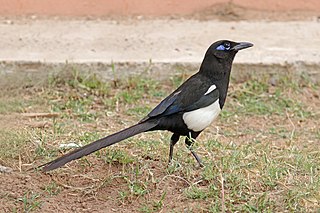
The Maghreb magpie is a species of magpie found in North Africa from Morocco east to Tunisia. It can be distinguished from the Eurasian magpie by the patch of blue skin behind its eye, the narrower white belly, the shorter wings, and the longer tail.

















